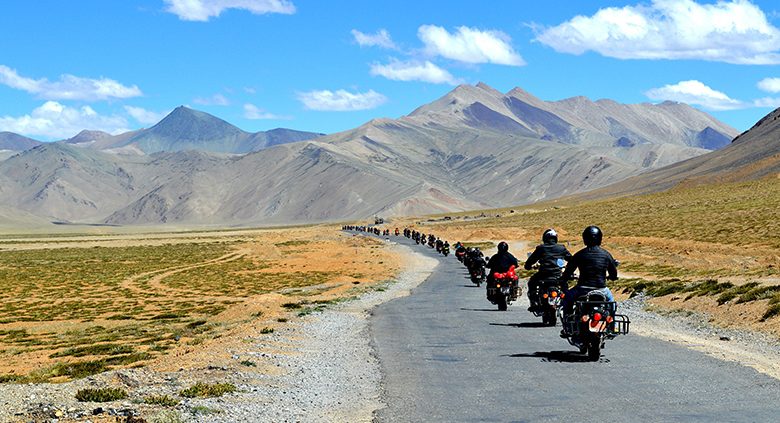
Markha Valley Trek
In Leh’s Main Bazaar, companies promoting the Markha Valley hike abound. However, don’t be misled into believing that this journey is suitable for everyone. It’s not going to be easy! It includes passing through two or three high-altitude mountain passes (16,000-17,000 feet above sea level) and sleeping at extremely high elevations for many nights. The draw of this trip is undeniably that it offers an exceptional blend of Ladakhi culture and lifestyle, as well as dramatic scenery with canyons and rock formations.
Find amazing camps at the best price here. Book now and explore with friends and family!
The Markha Valley is located south of Leh, between the Zanskar and Stok mountain ranges. Spituk, the trek’s beginning site, is conveniently located less than 30 minutes from Leh. The trail runs through Hemis National Park, with the road only ascending to Zingchen, the park’s entrance point. This is one of India’s largest and only protected national parks north of the Himalayas. . It is possible to camp without bringing a tent if desired. Accommodations in village homestays and local tea houses/parachute cafés (constructed from parachutes used by the military to drop supplies to troops) are plentiful.
The duration is 6 to 8 days. The entire journey takes ten days.
Moderately strenuous to extremely strenuous
1.5-3 hours on Day 6, 7-8 hours on Day 7, 3-4 hours on Day 8.
Spituk-Zingchen-Kandala Base Camp-Skiu-Markha-Thujungtse-Tsigu-Nyimaling-Shang Sumdo-Hemis Spituk-Zingchen-Kandala Base Camp-Ski-Markha-Thujungtse-Tsigu-Nyimaling-Shang Sumdo-Hemis Instead of walking down the route from Spituk, you may save a day by starting at Zingchen. There are a few different routes to choose from on this journey. If you’re feeling very fit, add a climb up Stok Kangri.
Panorama views from high altitude passes are among the highlights. Ruins of forts at Markha and Hankar. The journey concludes with a visit to the Hemis monastery.
-
Spituk-Stok Trek: Hemis National Park
The Markha Valley Journey is a shorter and more approachable version of the famous trek from Spituk to Stok. It begins at Spituk and follows the same path until it veers off across Stock Pass. This is the trek’s lone pass, at around 16,000 feet above sea level. Nature enthusiasts can stay in Rumbak hamlet for a couple of days and explore the nearby Hemis National Park with experienced local guides. Late in July, when the barley fields are in blossom, the region is exceptionally lovely. If you don’t feel up to the full journey, Zingchen to Rumbak is a modest half-day hike from which you may return without having to tackle the most challenging section.
Time frame: 4-5 days
Easy to moderate difficulty.
Days of Trekking: 4-6 hours on Day 1, 4-5 hours on Day 2, 4-5 hours on Day 3, 4 hours on Day 4, 4-6 hours on Day 5.
Spituk-Zingchen-Rumbak-Stock La Campsite-Stok is the route.
Views of the Indus Valley from Stok Pass are among the highlights. Hemis National Park’s flora and wildlife. At the end of the journey, we will visit Stok Palace.
From mid-June to late-September is the best time to visit.
-
Sham Trek (Likir-Temisgam)
Are you new to trekking? This is the most straightforward hike in Ladakh and an excellent place to begin. It will take you past settlements in the dry Sham area of Ladakh, which is located immediately north of the Indus River and west of Leh. Likir, the starting location, is 1.5 hours from Leh. For a variety of reasons, the trip is suitable for beginners: it is at a lower altitude than many other treks (all high passes are less than 13,000 feet above sea level), the distance between passes is short, and homestay accommodations are numerous. This allows the journey to be completed without the use of porters or guides. Even though this journey is commonly referred to as a “baby trek,” it is not without its difficulties.
Time frame: 4 days
Easy difficulty level.
Trekking hours per day: 4-5 hours on Day 1, 2-3 hours on Day 2, 3 hours on Day 3, and 4 hours on Day 5.
Likir-Yangthang-Hemis Shukpachen-Ang-Temisgam-Nurla is the route.
Highlights include the rugged and ever-changing terrain, as well as the monasteries of Likir and Ridzong.
When to go: Anytime between late May and late September is ideal (although you may want to avoid the warmer middle months).
-
Gompa Trek (Lamayuru-Alchi): Ancient Monasteries
This challenging trip, which is more difficult than the famous Markha Valley walk, passes through four of Ladakh’s oldest surviving monasteries. The walk is an excellent opportunity to learn about the region’s history. It begins at Lamayuru, roughly a 3-hour journey through the Sham Valley on the Srinagar-Leh Highway. This picturesque hamlet serves as the beginning point for many Ladakh treks. Despite the fact that the hamlet contains guesthouses, the Lamayuru Monastery is positioned majestically just above the camping grounds. The walk is difficult at times, but the crystal clear streams and views of the Zanskar Range make it worthwhile!
Time frame: 5-6 days
The difficulty level ranges from moderate to severe.
Lamayuru—Wanla—Hinju—Sumdha Chenmo—Sumdha Chun—Stakspi La-Alchi route
Highlights: The oldest monastery in Ladakh, Lamayuru Monastery, originates from the 11th century and is where the mystic Naropa communicated in a cave. The Alchi Monastery is known for its early Kashmiri Buddhist paintings.
From mid-June to late-September is the best time to visit.